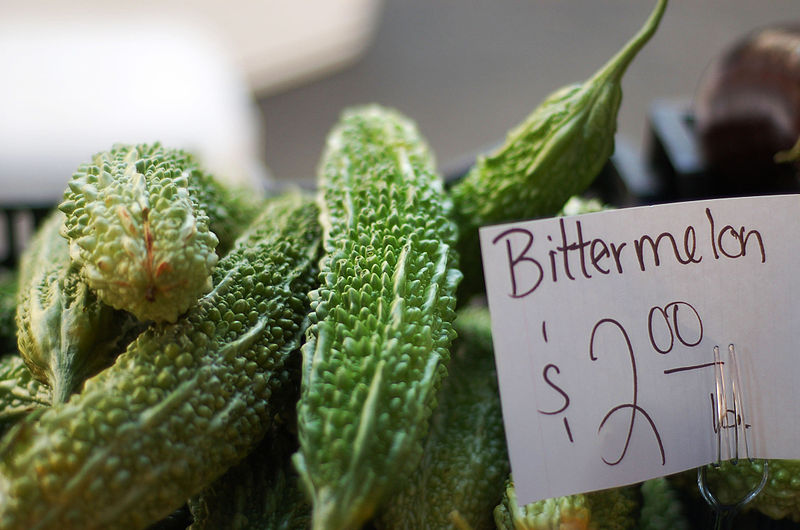Like most Chinese kids, I vividly remember my first bite of bitter melon. Instantly (and overwhelmingly) bitter, its eye-watering and tongue-curdling taste is certainly an acquired one. I enjoy eating it now, but there’s a reason that it’s the only edible in my mom’s garden—bitter melon is the only vegetable that the local deer and rabbits won’t eat.

Bitter melon. Yumm (for some). [Image by Britt Reints]
One could argue that kids (much like wild animals) initially hate veggies like bitter melon or brussel sprouts, because a natural aversion to bitter foods is evolutionarily adaptive. Today, bitterness has become a staple in our daily diet (hello, coffee), but it’s also a common characteristic of many toxic compounds. Taste perception isn’t just an evolutionary quirk that makes life more enjoyable—it was essential for knowing what to eat, and what to avoid:1
- Sweet and umami signal higher caloric content
- Salty indicates presence of necessary electrolytes
- Sour is typical of unripe or spoiled food
- and… Bitter warns against poisonous substances!
Bitter taste perception is mediated by TAS2Rs (taste receptors, type 2) in our taste buds; we may only have 25 different TAS2Rs, but can recognize tens of thousands of bitter compounds.2 Presumably, more taste receptors allows for broader detection of bitter (and potentially toxic) compounds. Indeed, species that have a more plant-based diet tend to have more TAS2Rs; given that plants typically contain more toxic compounds than meat, this makes sense.3

Guinea pigs (with their 69 TAS2Rs and fully vegetarian diet) have to worry more about toxic plant alkaloids than bottlenose dolphins (who have 0 TAS2Rs). [Image by Darren Johnson]
Until recently, TAS2Rs were thought to be expressed only in taste buds—but they’re also found in respiratory epithelia, gastrointestinal tissues, reproductive organs, and even the brain.4 Their functions outside of taste perception are still unclear, but new research suggests that TAS2Rs could be a therapeutic target for respiratory conditions like asthma or chronic obstructive lung disease. Human airway smooth muscle (ASM) actually expresses 6 different TAS2Rs, which can be stimulated for bronchodilation.5 In the taste buds, activation of TAS2Rs leads to an increase in calcium that eventually initiates neurotransmission; in ASM, the increase in calcium actually relaxes the airways, increasing airflow to the lungs!6
Currently, the only direct bronchodilators being used are β-agonists, which can become less effective after repeated use; in contrast, TAS2R agonists don’t seem to desensitize.7 Tests are still ongoing, but research on TAS2R-based therapies seems promising. In taste perception, bitter might mean “bad”, but in the future, bitter for asthmatics might potentially be life-saving.
Explore some specific TAS2Rs:
- TAS2R43 and TAS2R44 recognize saccharin, an artificial sweetening agent found in Sweet ‘n Low! Although initially sweet, if consumed at high concentrations, saccharin can have a bitter aftertaste.8
- TAS2R1, TAS2R14, TAS2R40 recognize humulone, which is found in the resin of mature hops. Alpha acids, like humulone, give beer that special bitter pucker!9
- TAS2R38 recognizes isothiocyanates, which are found in such beloved foods as wasabi, horseradish, mustard, and brussel sprouts! It also recognizes limonin, which is in citrus fruits like lemon, orange, and grapefruit.1011
- TAS2R10 and TAS2R14 recognize thujone, one of the compounds in absinthe! (Also found in sage and oregano).12
REFERENCES:
- Behrens M, Meyerhof W. (2013) Bitter taste receptor research comes of age: from characterization to modulation of TAS2Rs. Semin Cell Dev Biol 24(3):215-21. [↩]
- Liggett SB. (2014) Bitter taste receptors in the wrong place: novel airway smooth muscle targets for treating asthma. Trans Am Clin Climatol Assoc 125:64-74. [↩]
- Li D, Zhang J. (2014) Diet shapes the evolution of the vertebrate bitter taste receptor gene repertoire. Mol Biol Evol 31(2):303-9. [↩]
- Behrens M, Meyerhof W. (2013) Bitter taste receptor research comes of age: from characterization to modulation of TAS2Rs. Semin Cell Dev Biol 24(3):215-21. [↩]
- Liggett SB. (2014) Bitter taste receptors in the wrong place: novel airway smooth muscle targets for treating asthma. Trans Am Clin Climatol Assoc 125:64-74. [↩]
- Liggett SB. (2014) Bitter taste receptors in the wrong place: novel airway smooth muscle targets for treating asthma. Trans Am Clin Climatol Assoc 125:64-74. [↩]
- Liggett SB. (2014) Bitter taste receptors in the wrong place: novel airway smooth muscle targets for treating asthma. Trans Am Clin Climatol Assoc 125:64-74. [↩]
- Meyerhof W, Batram C, Kuhn C, Brockhoff A, Chudoba E, Bufe B, Appendino G, Behrens M. (2010) The molecular receptive ranges of human TAS2R bitter taste receptors. Chem Senses 35(2):157-70. [↩]
- Meyerhof W, Batram C, Kuhn C, Brockhoff A, Chudoba E, Bufe B, Appendino G, Behrens M. (2010) The molecular receptive ranges of human TAS2R bitter taste receptors. Chem Senses 35(2):157-70. [↩]
- Behrens M, Meyerhof W. (2013) Bitter taste receptor research comes of age: from characterization to modulation of TAS2Rs. Semin Cell Dev Biol 24(3):215-21. [↩]
- Meyerhof W, Batram C, Kuhn C, Brockhoff A, Chudoba E, Bufe B, Appendino G, Behrens M. (2010) The molecular receptive ranges of human TAS2R bitter taste receptors. Chem Senses 35(2):157-70. [↩]
- Meyerhof W, Batram C, Kuhn C, Brockhoff A, Chudoba E, Bufe B, Appendino G, Behrens M. (2010) The molecular receptive ranges of human TAS2R bitter taste receptors. Chem Senses 35(2):157-70. [↩]

Trackbacks/Pingbacks